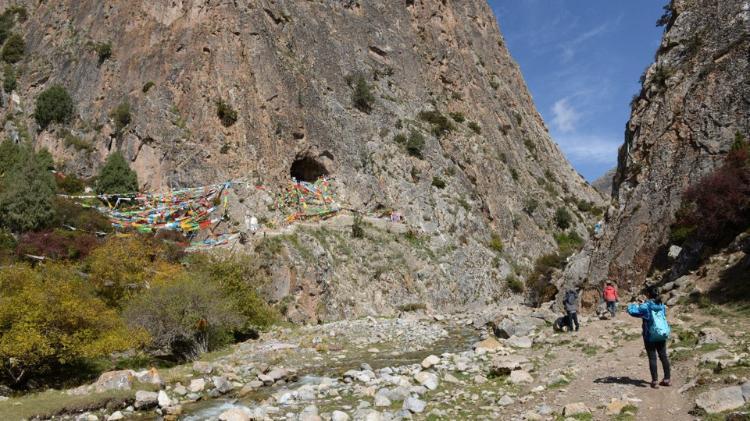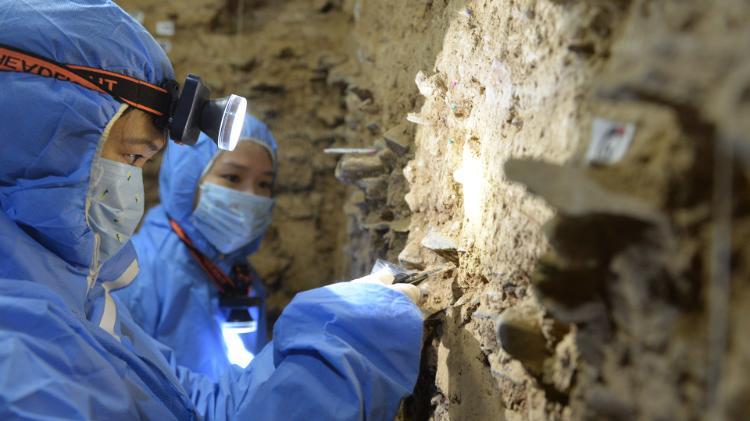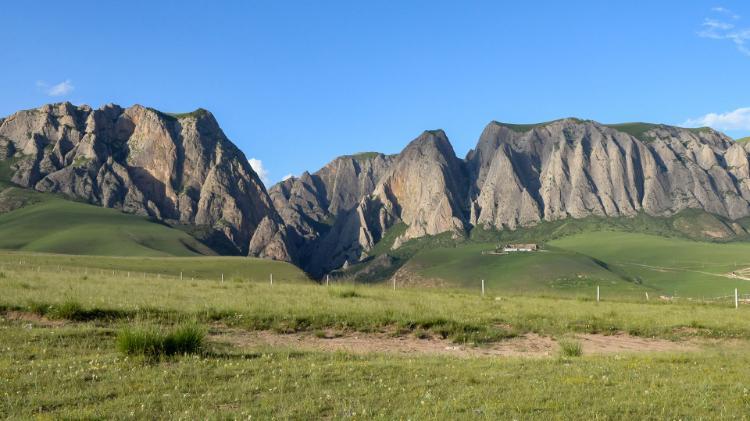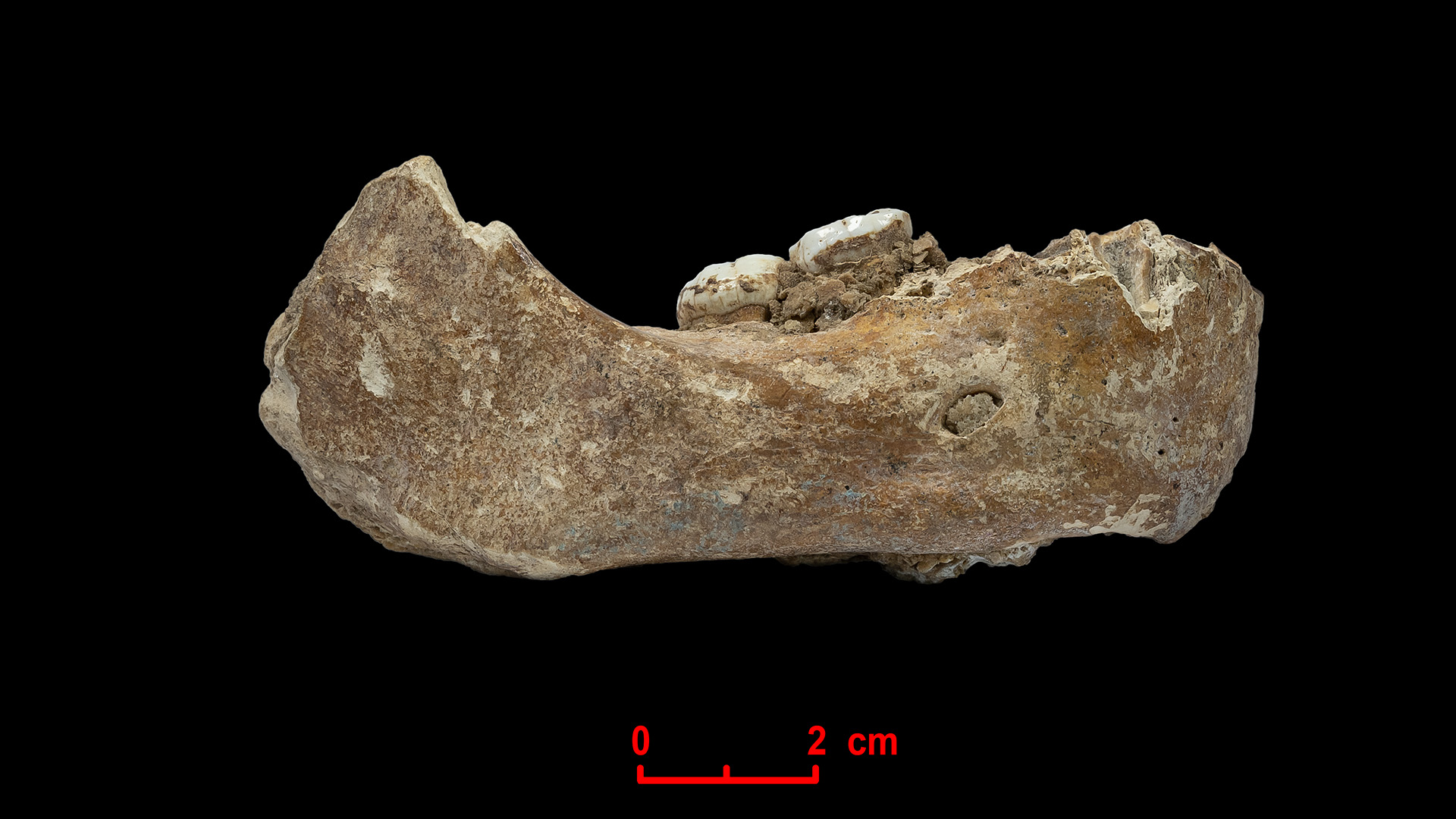October 30, 2020
Study confirms Denisovan presence on ‘the roof of the world’
New evidence shows ancient human species occupied Tibetan cave
New research from a cave site in Tibet has found evidence that Denisovans, an ancient population of humans closely related to Neanderthals, occupied the cave from at least 100,000 years ago (possibly as early as 190,000 years ago) to 60,000 years ago, and probably as recently as 45,000 years ago.
The study confirms the site, Baishiya Karst Cave on the Tibetan Plateau, as the first location outside of Denisova Cave in Siberia that is known to have been occupied by Denisovans. A mandible (pictured above) found at the cave decades ago by a Buddhist monk had been identified as Denisovan in a recent study, but the identification was tenuous, based on a single amino acid position.
An international team of archaeologists, geologists and geneticists, including University of Wollongong (UOW) dating specialists Associate Professor Bo Li and Professor Zenobia Jacobs, carried out further research in the cave and found Denisovan DNA in Baishiya Karst Cave along with stone tool artefacts and animal bones.
The research results, ‘Denisovan DNA in Late Pleistocene sediments from Baishiya Karst Cave on the Tibetan Plateau’, are published in the prestigious journal Science this week.

The entrance to Baishiya Karst Cave, on the Tibetan Plateau.
Baishiya Karst Cave, a Buddhist Sanctuary, is 2,800km from Denisova Cave and at a much higher altitude at 3280m above sea level.
Professor Li said the study supports the idea that Denisovans had a wide geographic distribution not limited to Siberia.
“We have known that some modern human genomes contain fragments of DNA from Denisovans, suggesting that this species of human must have been widespread in Asia.” Professor Li said.
“However, before 2019, the remains of Denisovans were found at only one site, Denisova Cave, Siberia, and we do not know what they looked like, except for some tiny bones and their DNA structure.
“The mandible discovered from Baishiya Karst Cave is so far the largest fossil of Denisovan, and also the only remains found outside Siberia.
“Furthermore, it was discovered on the Tibet Plateau, on the ‘roof of the world’, more than 3000m above sea level, indicating that modern Tibetan people may have inherited some of their genes to adapt to high-altitude environment.”
Because the cave is a Buddhist holy site the archaeologists had to negotiate permission to carry out excavations and were only allowed to do so at certain areas and at certain times – being the cave entrance at night during the middle of winter. Even so, they found rich deposits of stone tools and animal bones in numerous layers of the sediment.
While they didn’t find any further Denisovan bones, they did find Denisovan DNA present in the soil.

Researchers collecting sediment samples from the excavation site inside the cave.
“We found firm evidence for the long-term presence of Denisovans in Baishiya Karst Cave and provided stratigraphic and chronological context for their occupation in the cave, confirming the occupation of Denisovans on the Tibetan Plateau,” Professor Li said.
“We detected ancient human fragments that matched mitochondrial DNA associated with Denisovans in four different layers of sediment deposited around 100,000 and 60,000 years ago.
“Interestingly, we found that the hominin DNA from 60,000 years ago share the closest genetic relationship to the Denisova 3 and 4 specimens sampled from Denisova Cave. In contrast, the DNA dating to 100,000 years ago show evidence that those Denisovans separated earlier from the lineage leading to Denisova 3 and 4.”
The UOW team lead the dating study, producing the ages for the artefacts and DNA bearing sediments, which was crucial for understanding the occupation history of the cave.
“We determined that the upper sedimentary layers in the cave were extensively disturbed, but that the lower layers were still intact. This made dating of the site challenging,” Professor Li said.
“We needed to employ cutting-edge techniques, developed here at UOW by our team. Our new methods allowed us to check the stratigraphic integrity, identify any post-depositional disturbance, and construct a robust chronology for the site.”

Baishiya in Ganjia Basin, China, where the cave is located.
In addition to the dates for the sedimentary DNA, the mandible was dated to more than 160,000 years ago, and the stone artefacts (most probably made by Denisovans) can be dated to more than 190,000 years ago and to as recently as 45,000 years ago.
Professor Li said there was a lot more to learn from the site.
“The excavation is ongoing and dating work is continuing in our lab, in collaboration with Professor Dongju Zhang (from Lanzhou University, China), who is in charge of the excavation of the site,” he said.
“Our next target is to date more samples from the cave, and try to answer when Denisovans started to occupy the cave and when they ‘disappear’ from the cave.”
ABOUT THE RESEARCH
‘Denisovan DNA in Late Pleistocene sediments from Baishiya Karst Cave on the Tibetan Plateau’ by Dongju Zhang et al. is published in Science.
Bo Li and Zenobia Jacobs were funded by Australian Research Council Future Fellowships. The study also received funding from the Second Tibetan Plateau Scientific Expedition and Research Program and the Strategic Priority Research Program of the Chinese Academy of Sciences; the National Natural Science Foundation of China; Tencent Foundation; Zhengzhou University; and the Strategic Innovation Fund of the Max Planck Society.
